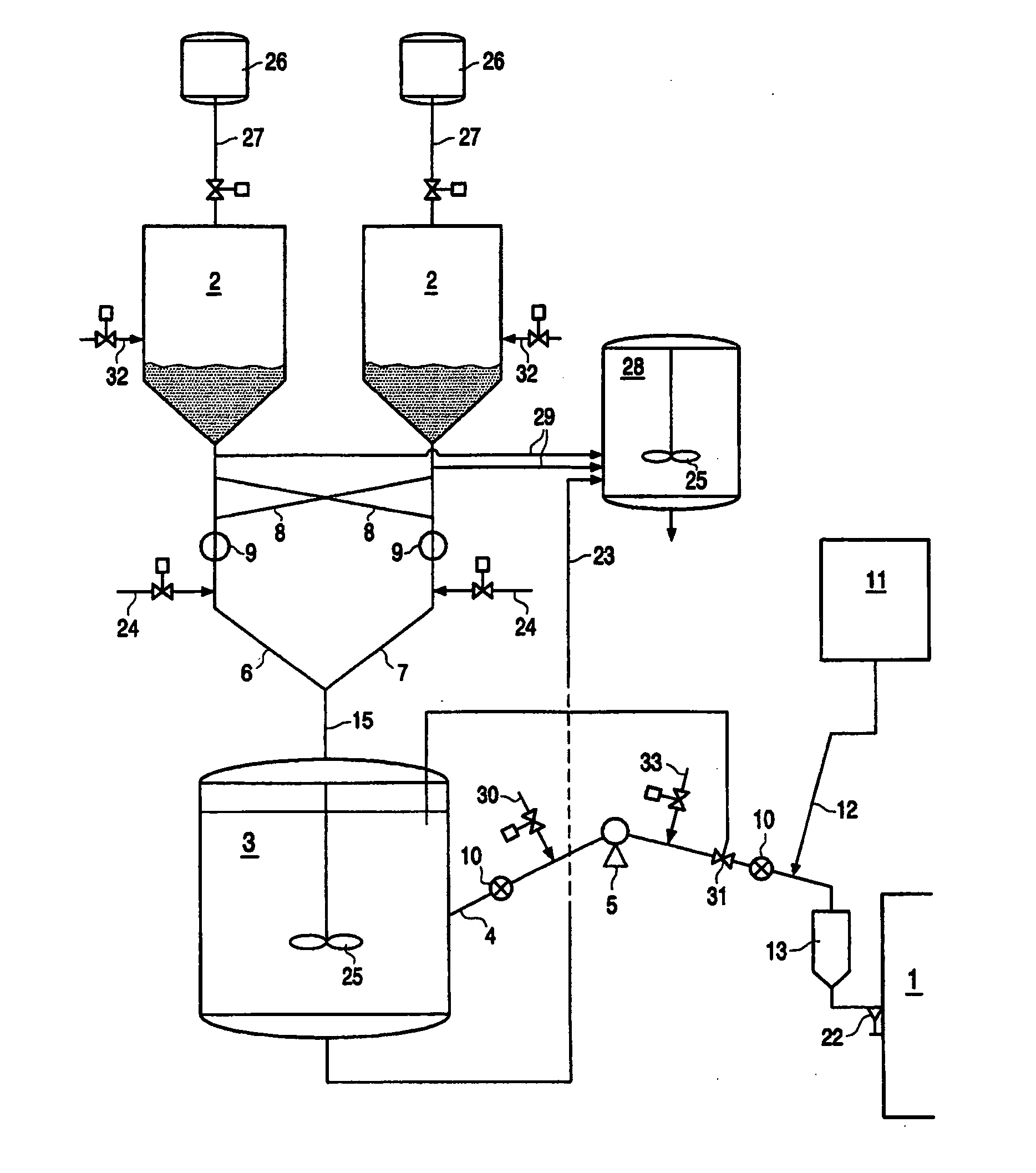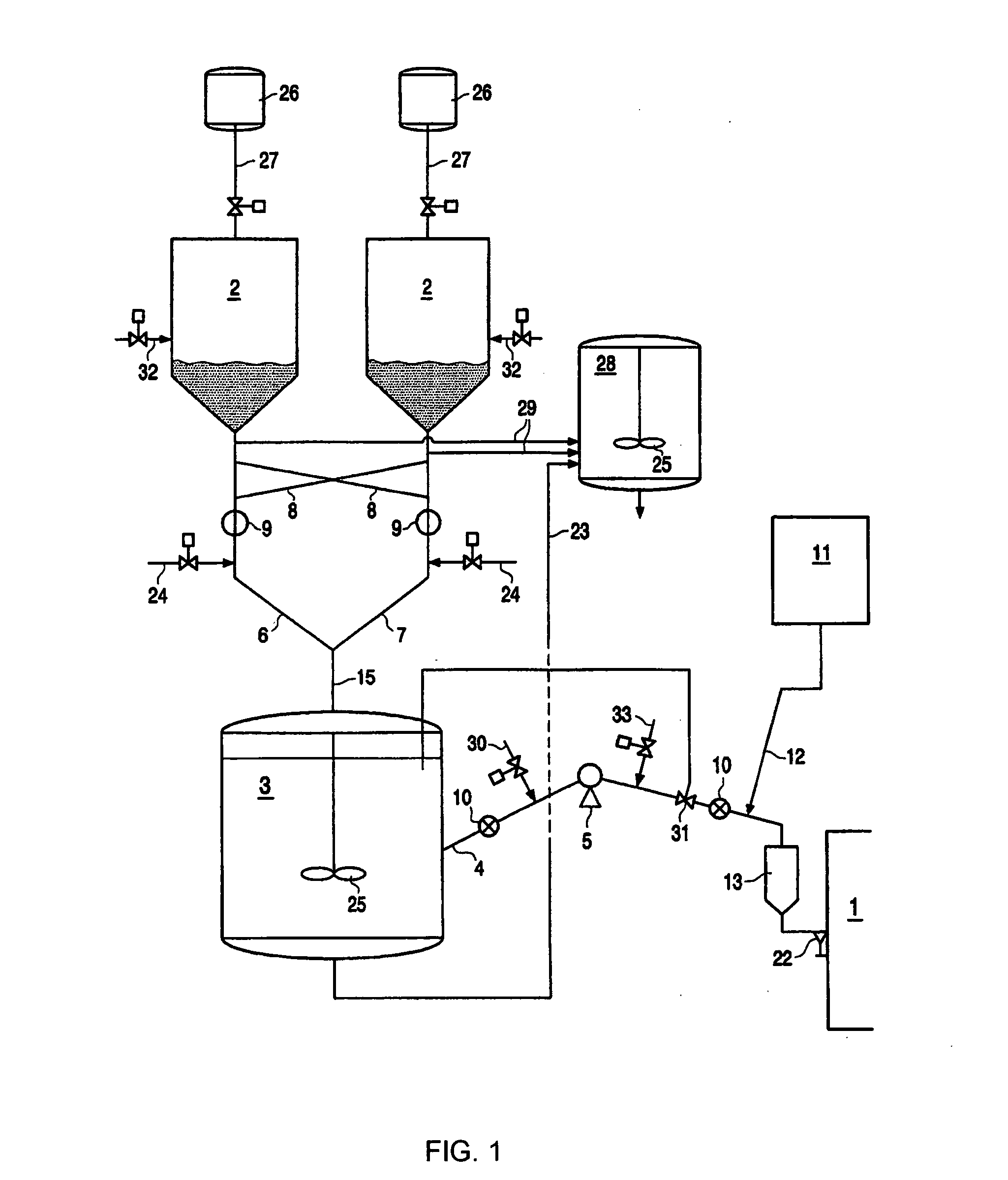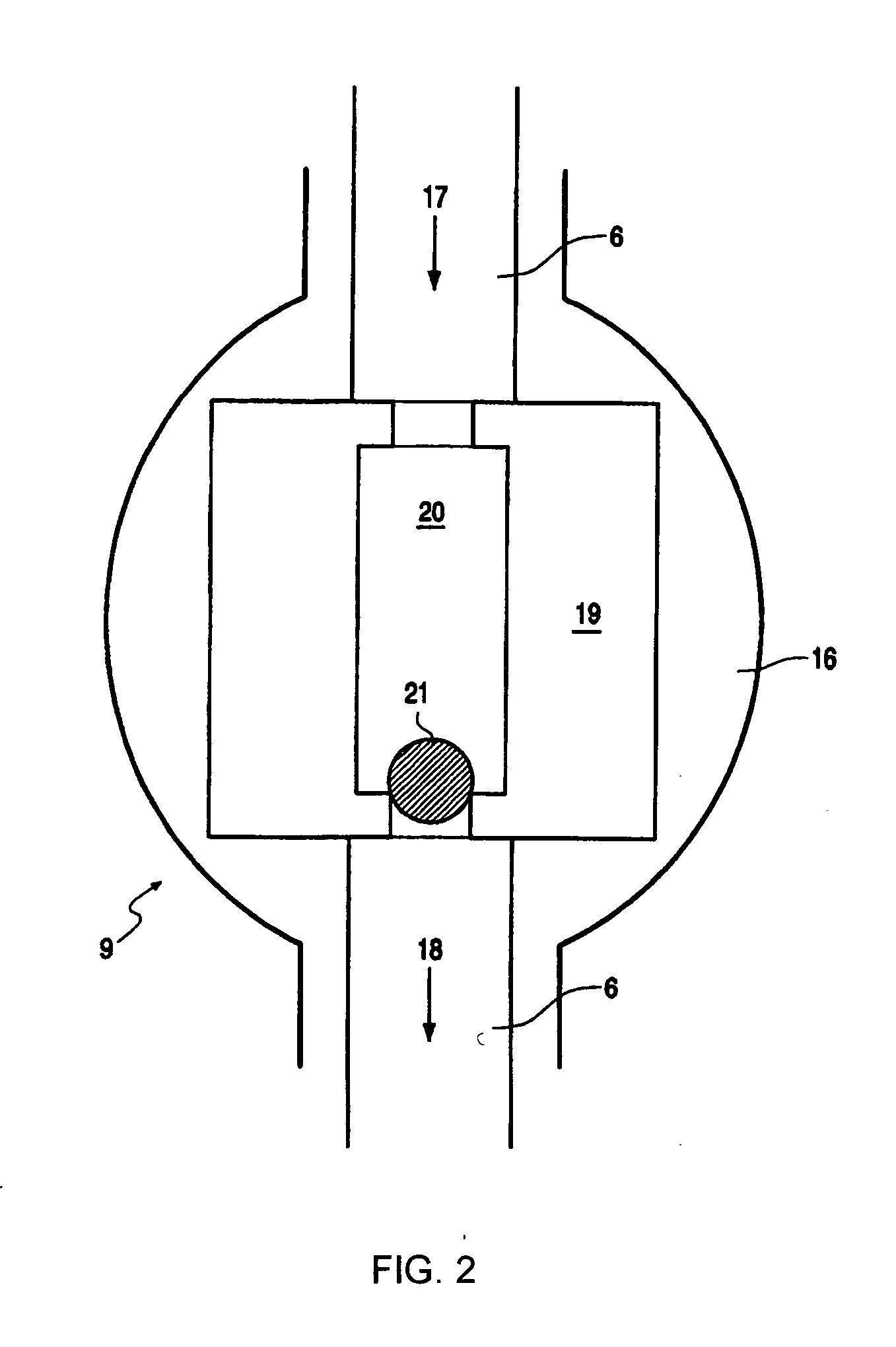An increase in the molecular weight of a polyolefin resin can improve certain physical properties of the resin, however, high molecular weights can also tend to make polymers more difficult to process.
Mechanical efforts have been used in an effort to prepare resins having broad and / or bimodal MWD by blending polyolefin portions having different molecular weights, however, the results of mechanical blends are limited by the degree of physical mixing that is possible and the size of the particles being mixed, typically in a pellet type form.
Mechanical means do not result in the mixing of various polyolefin
pellets on a
microscopic scale, and therefore will not behave like an intimate blend of polyolefins that are prepared in-situ within a common
polymerization process.
However, it is important to control catalyst flow to a reactor since unexpected or uncontrolled catalyst injection in a reactor could lead to runaway reactions.
Direct feeding of catalyst
slurry from a storage vessel to a reactor has the
disadvantage that the feeding rate of the catalyst to the reactor cannot be adequately controlled.
Also, in cases involving direct feeding of a catalyst from a mud pot to a reactor, the
metallocene catalyst can be completely flushed in the reactor, when a problem occurs during the preparation of the
metallocene catalyst.
Such uncontrolled catalyst feeding may induce runaway reactions in the reactor.
However, such technique does not allow bringing the co-catalyst into contact with the
metallocene catalyst before entering the reactor, although such pre-contact is particularly desirable in order to provide effective catalyst-co-catalyst mixtures.
In this latter case, however, having regard to the fact that the catalyst systems employed usually have maximum activity at the commencement of polymerization, it may be difficult to avoid reaction runaways liable to involve the formation of hot spots and of agglomerates of molten
polymer.
A major problem in such co-polymerization process is that the control of reaction parameters is very difficult.
Swelling refers to the process whereby formed polymer particles are dissolved in
diluent, giving rise to polymer
slurry which is more viscous, which has undesired properties, and which may block the
polymerization reactor.
However, this provides disadvantages including safety problems, related to the fact that these organometallic compounds spontaneously ignite on contact with air.
However, one of the major problems in the injection of Ziegler-
Natta catalyst
slurry in a
diluent to a reactor in prior art methods is that it is difficult to control the amount of Ziegler-
Natta catalyst injected.
Also, the catalyst tends to clog catalyst injection means such as pumps and the like and lines carrying the slurry.
Moreover, another problem relates to catalyst supply is that it has been difficult to control Ziegler-
Natta catalyst flow rate in an adequate way.
Another problem relating to the field of catalyst supply to a reactor consists of supplying a co-catalyst during a polymerization reaction.
However, such methods do not allow bringing co-catalyst into contact with the Ziegler-Natta catalyst before entering the reactor, although such pre-contact is particularly desirable in order to provide effective Ziegler-Natta catalyst-co-catalyst mixtures.
In this latter case, however, it is difficult to control the pre-
contact time of the catalyst with the co-catalyst.
It is important to control catalyst flow to a reactor since unexpected or uncontrolled catalyst injection in a reactor could lead to runaway reactions.
However, one of the major problems in the injection of catalyst slurry to a reactor in prior art methods is that it is difficult to control the amount of catalyst and the flow rate of the catalyst injected.
Furthermore, direct feeding of catalyst slurry to a reactor has the disadvantage that the feeding rate of the catalyst to the reactor cannot be adequately controlled.
Also, in cases involving direct supply of a catalyst to a reactor, the catalysts can completely be flushed in the reactor, when a problem occurs during the preparation of the catalysts.
Such uncontrolled catalyst supply may induce runaway reactions in the reactor.
Moreover, in the case catalyst in oil suspension is provided directly to a reactor, the used pumps, generally progressive cavity pumps, are not able to
dose the catalyst flow and the amount of catalyst injected in the reactor.
Furthermore, such systems require the switch over of the catalyst injection
system, every time a new batch of catalyst needs to be connected to the reactor for supply thereto.
Therefore, such injection systems do not provide an optimal and reliable control of the catalyst flow rate.
However, it has been found on an
industrial scale that while the polymer particles are insoluble or substantially insoluble in the
diluent, the polymer product has some tendency to deposit on the walls of the polymerization reactor.
This so-called “
fouling” leads to a decrease in the efficiency of heat exchange between the reactor bulk and the
coolant around the reactor.
This leads in some cases to loss of reactor control due to overheating, or to reactor or downstream polymer
processing equipment failure due to formation of agglomerates (ropes, chunks).
This “
fouling” is caused in part by fines and also by the build up of electrostatic charge on the walls on the reactor.
However, there have been some problems associated with prior known agents, particularly in relation to polymerization processes using
chromium-type catalysts and sometimes Ziegler-Natta type catalysts.
These problems include an increase of catalyst consumption due to loss of activity in the presence of the anti-
fouling agent.
Other problems with prior known agents relate to problems of
toxicity.
Finally, practical problems are encountered with many previously known anti-fouling agents.
These practical problems arise because some antifouling agents are
usable only with a given catalyst type.
This makes transitions between catalyst systems during
processing more difficult.
When any one of the three parameters just mentioned (monomer and optional
comonomer concentration, temperature and
solid content) increases above a certain level, depending upon the polymer characteristics and upon the reactor characteristics, it is additionally observed that the level of
noise of this
power consumption starts increasing gradually and if not properly controlled may provoke the safety shut-down of operations.
Unfortunately, the most usual cause of swelling is high
solid content.
However, it has been found on an
industrial scale that where the polymer is insoluble or substantially insoluble in the diluent, the polymer product has a tendency to deposit on the wall of the polymerization reactor.
This so-called “fouling” leads to a decrease in the efficiency of heat exchange between the reactor bulk and the
coolant around the reactor.
This “fouling” is caused by a combination of fines and the build up of electrostatic charge in the
powder.
However, there has been a problem with prior known agents, particularly in relation to polymerization processes using
chromium-type catalysts or Ziegler-Natta type catalysts because of loss of activity of the catalyst due to the presence of the anti-fouling agent.
Other problems with prior known agents relate to problems of
toxicity.
However, there are a number of problems associated with increasing the monomer concentration, as discussed below.
This heat production may be extremely dangerous if it is not controlled.
Clearly a build-up of heat in a reactor containing flammable hydrocarbons may lead to fires or explosions.
Secondly, the reactors are usually jacketed with a cooling
system, such as with a
water jacket.
However, generally these methods have only been suitable for monomer concentrations of from 4-6.5 wt.
This is because a further problem exists with increasing monomer concentration.
The gas formed can lead to dangerous pressure build-up.
In addition, the release of monomer from the
solvent reduces the monomer available for reaction, unbalancing the carefully selected concentration of reactants and leading to undesirable products and impurities.
This may have the effect of reducing the efficiency of the process rather than increasing it.
Finally, the reactants are typically pumped around the reactor loop for efficient mixing and cooling, but the pumps are designed to pump liquids and will not function properly if gas is present.
However, the slurry in said standpipe is generally not in equilibrium with the reactants, and hence it is almost entirely impossible to obtain a representative sample.
In polymerization plants using flash tanks which are connected to a reactor by means of flash lines and
settling legs, the
settling legs themselves can present problems.
Analysis of a gas sample taken from the flash tank does not provide updated information on the
reaction conditions in the polymerization reactor and will result in an inaccurate analysis of the
gas composition in the polymerization reactor.
However the above-described devices and methods do not allow the control of several different variables of the polymerization process, such as e.g. monomer, co-monomer and
hydrogen in the
gas phase and properties of the polymerization product such as the
melt flow index and density, in response with the analysis of the sample.
An important operational cost is linked to this fluid
effluent recycling.
Classically, operation of the
plant is based on attempting to
discharge the same amount of slurry from all settling legs in order to afford equivalent pressure drops when discharging each leg, however this operation may be far from optimal.
However the above-described apparatus and processes have the disadvantage that the suspension withdrawn from the reactor still contains a large amount of diluent and of other reactants, such as the monomer, which it is then necessary to subsequently separate from the polymer particles and to treat for the purpose of reusing it in the reactor.
The first solution is extremely capital intensive.
The second one is extremely time and operation consuming.
. . Connections can often be damaged and the risk for a catastrophic accident is real so that operations are not smooth and are slow down anyway.
In these polymerization processes, settling legs, however, do present some problems.
Each time a settling leg reaches the stage where it “discharges” or “fires” accumulated polymer slurry it causes interferences on the pressure in the loop reactor, which is thereby not kept constant.
At very high monomer concentration, such pressure fluctuations may generate several problems such as the creation of gas bubbles that may cause trouble in the operation of the circulation pump.
They may also provoke perturbations in the control scheme of the reactor pressure.
However the above-described apparatus and processes have the disadvantage that the suspension withdrawn from the reactor still contains a large amount of diluent and of other reactants, such as the monomer and optionally the
comonomer, which subsequently have to be separated from the polymer particles and to treat for the purpose of reusing it in the reactor.
Another disadvantage of the above-described apparatus and processes is their lack of flexibility during the phase or reaction start-up or in response to large disruptions in the normal behavior of the reactor, like sudden interruption of one of the feed streams.
However, problems associated with known polymerization processes and apparatuses using a polymerization
system having two or more serially disposed polymerization reactor vessels, include inaccurate inter-reactor transfer of polymer slurry between the serially disposed reactors, while maintaining each reactor at independently selected operating conditions.
Frequent plugging causes system down time, lost final product and raw materials, and increased operating costs.
However, a problem associated with this type of configuration is that it requires the positioning of the reactors in a vertical arrangement, which is generally technically limited and results in increased fabrication costs.
Also in such configurations the reactors are positioned close to one another, which limits their
accessibility.
 Login to View More
Login to View More 


